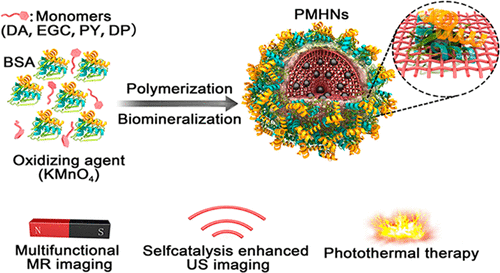Our official English website, www.x-mol.net, welcomes your
feedback! (Note: you will need to create a separate account there.)
Integration of Polymerization and Biomineralization as a Strategy to Facilely Synthesize Nanotheranostic Agents
ACS Nano ( IF 15.8 ) Pub Date : 2018-12-03 00:00:00 , DOI: 10.1021/acsnano.8b07584 Bing Xiao 1 , Xiaoxuan Zhou 2 , Hongxia Xu 1 , Bihan Wu 1 , Ding Hu 1 , Hongjie Hu 2 , Kanyi Pu 3 , Zhuxian Zhou 1 , Xiangrui Liu 1 , Jianbin Tang 1 , Youqing Shen 1
ACS Nano ( IF 15.8 ) Pub Date : 2018-12-03 00:00:00 , DOI: 10.1021/acsnano.8b07584 Bing Xiao 1 , Xiaoxuan Zhou 2 , Hongxia Xu 1 , Bihan Wu 1 , Ding Hu 1 , Hongjie Hu 2 , Kanyi Pu 3 , Zhuxian Zhou 1 , Xiangrui Liu 1 , Jianbin Tang 1 , Youqing Shen 1
Affiliation

|
Integration of biological macromolecules with inorganic materials via biomineralization has demonstrated great potential for development of nanotheranostic agents. To produce multifunctionality, integration of multiple components in the biomineralized theranostic agents is required; however, how to efficiently and reproducibly implement this is challenging. In this report, a universal biomineralization strategy is developed by incorporation of oxidization polymerization into albumin-templated biomineralization for facile synthesis of nanotheranostic agents. A series of biomineralized polymers and manganese dioxide hybrid nanoparticles (PMHNs) can be synthesized via the polymerization of various monomers, including dopamine (DA), epigallocatechin (EGC), pyrrole (PY), and diaminopyridine (DP), along with the reduction of KMnO4 and formation of manganese dioxide nanoparticles in albumin templates. These biomineralized PMHNs demonstrate ultrahigh MRI (longitudinal relaxivity up to 38 mM–1 s–1) and ultrasonic (US) imaging contrasting capabilities and have excellent photothermal therapy efficacy with complete ablation of orthotopic tumors. Moreover, these biomineralized hybrid nanoparticles can be effectively excreted through the kidneys, avoiding potential systemic toxicity. Thus, integration of polymerization into biomineralization presents a strategy for the fabrication of hybrid nanomaterials, allowing the production of multifunctional and biocompatible nanotheranostic agents via a facile one-pot method.
中文翻译:

聚合和生物矿化的整合,作为一种策略,可以方便地合成纳米治疗剂。
通过生物矿化将生物大分子与无机材料整合,已显示出开发纳米热试剂的巨大潜力。为了产生多功能性,需要将多种成分整合到生物矿化治疗剂中。然而,如何有效和可重复地实现这一点是具有挑战性的。在本报告中,通过将氧化聚合反应纳入白蛋白模板化的生物矿化过程中,开发了一种通用的生物矿化策略,从而可以轻松合成纳米级热疗剂。一系列生物矿化聚合物和二氧化锰的混合纳米粒子(PMHNs)可以合成通过包括多巴胺(DA),表没食子儿茶素(EGC),吡咯(PY)和二氨基吡啶(DP)在内的各种单体的聚合,以及KMnO 4的还原和白蛋白模板中二氧化锰纳米颗粒的形成。这些生物矿化的PMHN表现出超高MRI(纵向松弛度,最高38 mM –1 s –1)和超声(US)成像对比功能,并具有出色的光热疗法功效,可完全切除原位肿瘤。此外,这些生物矿化的杂化纳米颗粒可以通过肾脏有效排泄,避免了潜在的全身毒性。因此,将聚合反应整合到生物矿化中提出了一种制备杂化纳米材料的策略,允许通过一种简便的一锅法生产多功能且生物相容的纳米热试剂。
更新日期:2018-12-03
中文翻译:

聚合和生物矿化的整合,作为一种策略,可以方便地合成纳米治疗剂。
通过生物矿化将生物大分子与无机材料整合,已显示出开发纳米热试剂的巨大潜力。为了产生多功能性,需要将多种成分整合到生物矿化治疗剂中。然而,如何有效和可重复地实现这一点是具有挑战性的。在本报告中,通过将氧化聚合反应纳入白蛋白模板化的生物矿化过程中,开发了一种通用的生物矿化策略,从而可以轻松合成纳米级热疗剂。一系列生物矿化聚合物和二氧化锰的混合纳米粒子(PMHNs)可以合成通过包括多巴胺(DA),表没食子儿茶素(EGC),吡咯(PY)和二氨基吡啶(DP)在内的各种单体的聚合,以及KMnO 4的还原和白蛋白模板中二氧化锰纳米颗粒的形成。这些生物矿化的PMHN表现出超高MRI(纵向松弛度,最高38 mM –1 s –1)和超声(US)成像对比功能,并具有出色的光热疗法功效,可完全切除原位肿瘤。此外,这些生物矿化的杂化纳米颗粒可以通过肾脏有效排泄,避免了潜在的全身毒性。因此,将聚合反应整合到生物矿化中提出了一种制备杂化纳米材料的策略,允许通过一种简便的一锅法生产多功能且生物相容的纳米热试剂。











































 京公网安备 11010802027423号
京公网安备 11010802027423号